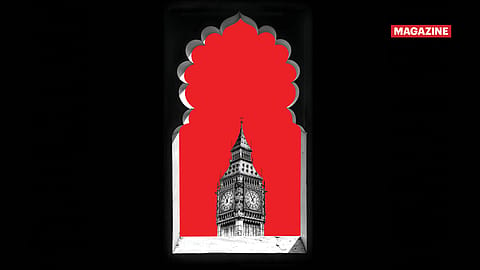India-UK CETA paves the way for overseas business growth
India’s concessions to the U.K. are signs that New Delhi is confident of its potential to become an economic powerhouse, the U.S. President’s ‘tariff plus penalty’ notwithstanding.

This story belongs to the Fortune India Magazine Aug 2025 issue.
IF YES MINISTER, the popular British sitcom of the 1980s, were set in Whitehall today, the India-U.K. Free Trade Agreement (FTA) would have made for a worthy plotline. And, commerce minister Piyush Goyal would have inspired his favourite show. As the Comprehensive Economic and Trade Agreement (CETA) was inked on July 24, the camaraderie between the leaders of the two nations was unmissable.
More than a trade deal, CETA displays India’s growing confidence, after decades of protectionism, in opening up what the U.K. expects to be a lucrative market with over a quarter of a billion high-income consumers by 2050. Goyal describes it as “a win-win for both nations, aiming to leverage each other’s strengths to achieve shared growth and prosperity”.
“The signing of CETA marks a strategic milestone in the bilateral economic relationship with a strong potential to deepen India’s integration into global value chains,” says Rudra Kumar Pandey, partner at law firm Shardul Amarchand Mangaldas & Co. Spanning across 26 sectors and with the promise of doubling bilateral trade by 2030 from the current nearly $56 billion, CETA is India’s most ambitious FTA to date. “The landmark CETA is a stellar example of how New India does business,” Goyal said on X. What’s striking is that its economic impact is not limited; it can become a template for ongoing and future FTA talks such as those with the EU and the U.S. Although U.S. President Donald Trump’s 25% tariff plus unspecified “penalty” is unprecedented, New Delhi is yet to show its hand.
With zero-duty access to the U.K. market for 99% of Indian goods, the FTA displays New Delhi’s negotiating power. The zero-duty access is expected to benefit several labour-intensive sectors that form the backbone of the MSME ecosystem and employ millions. Last fiscal, India exported goods worth $14.5 billion to the U.K. About $6.5 billion of these goods will now enter the duty-free category, trade experts say. For instance, exports of agri and processed food products are expected to rise by over 50% in the next three years. Similarly, leather and footwear exports are estimated to more than double to over $900 million from the current $440 million.
Meanwhile, British firms in the consumer, healthcare, aerospace, technology, and advanced manufacturing sectors will gain access to the Indian market with New Delhi’s reciprocal assurance to reduce or eliminate tariffs on 92% of imports. This prompted U.K. Prime Minister Keir Starmer to term the deal as “a major win for Britain”.
Another major move is India launching a dedicated Tariff Rate Quota for passenger cars, in a first. As a result, petrol cars above 3,000 cc and diesel cars over 2,500 cc will see a lowering of the current 100% plus customs duty to 10% over 15 years, with a quota starting at 10,000 units and rising to 19,000 by the fifth year. For mid-sized cars (1,500-2,500 cc diesel/up to 3,000 cc petrol), a 50% in-quota duty applies initially, falling to 10% by the fifth year. Small cars under 1,500 cc will see staggered tariff reductions.
Similarly, the total customs duty on imported alcoholic spirits — limited to whisky and gin — will be halved at the first stage of entry-into-force from 150% to 75%, followed by a progressive reduction to 40% over the next decade. In another first, India will open around 40,000 high-value contracts from Central ministries and departments in sectors such as transport, green energy, and infra to bidders from the U.K.
More Stories from this Issue
CETA also promises to expand India’s services exports from $19.8 billion, as of 2023, with more mobility for professionals across IT, healthcare, finance, and education. It allows for streamlined entry of contractual service suppliers, business visitors, intra-corporate transferees, and independent professionals such as yoga instructors, chefs, and musicians. The Double Contributions Convention will save Indian firms and workers ₹4,000 crore by removing the need for dual social security contributions.
Though it is still early days, hardly any Indian sector or segment has raised any major concern over CETA — an indication of the Narendra Modi government’s assessment of the strengths and capabilities of the domestic industry.
A trade deal between the two countries is “a floor, not a ceiling of our ambitions,” Britain’s foreign secretary David Lammy had said while on an India visit in July 2024. Exactly a year later, the diplomatic waltz has ensured the deal is a reality. But how will it play out? The next couple of years will reveal that. For now, the mood is positive.